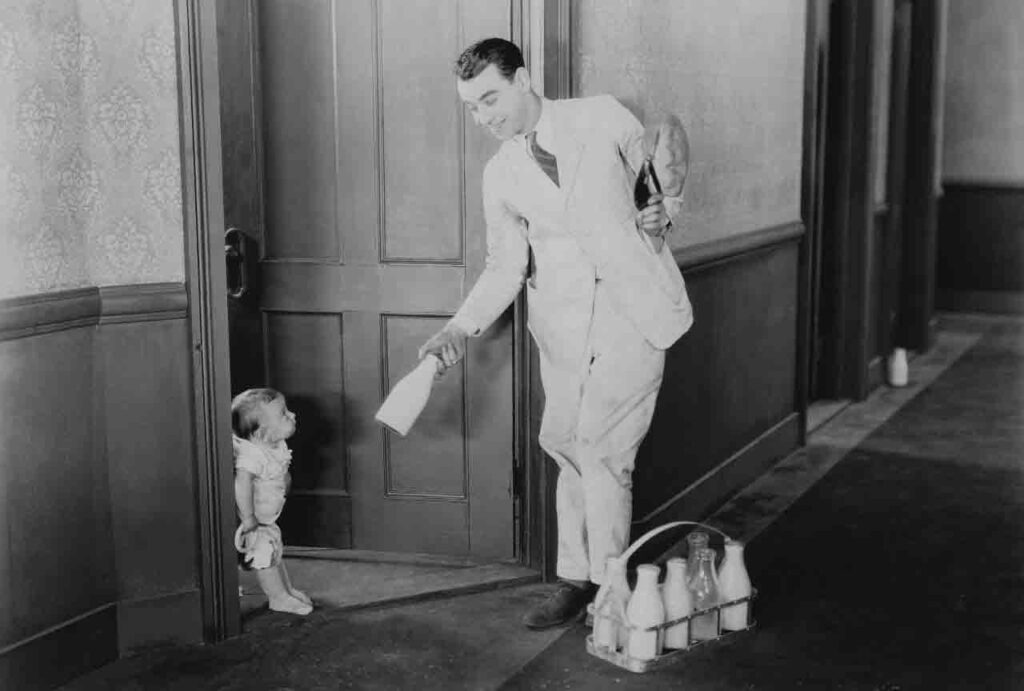Jobs have always evolved to meet the needs of society, shaped by advancements in technology, changes in industries, and shifting cultural priorities. Over time, certain professions that once played vital roles in daily life have disappeared, leaving behind fascinating stories of how people once worked. These “jobs that no longer exist” offer a glimpse into the past and show how human ingenuity continuously reshapes the workforce.
Whether it’s a job replaced by technology or one rendered obsolete by societal changes, each example highlights the resilience and innovation of human progress.
20 Jobs That No Longer Exist
1. Knocker-Upper
Before alarm clocks became widely available, individuals known as knocker-uppers were hired to wake people up at specific times. They used tools such as long sticks or small pebbles to tap on windows and ensure their clients didn’t oversleep. This profession was especially common during the Industrial Revolution, when workers needed to wake up early for factory shifts. As affordable and reliable alarm clocks became household staples, the role of the knocker-upper gradually vanished, making it one of the notable jobs that no longer exist.
2. Lamplighter
Lamplighters were responsible for lighting and extinguishing gas street lamps in towns and cities before electric lighting became standard. They typically carried ladders and torches to perform their duties. The job was crucial for maintaining public safety during the evenings. However, with the introduction of electric streetlights, the need for manual lamp maintenance disappeared, leading to the decline of this occupation. Lamplighters are now part of history, representing a bygone era of urban infrastructure.
3. Resurrectionist
Resurrectionists, also known as body snatchers, operated in the 18th and 19th centuries when medical schools faced a shortage of cadavers for dissection and study. These individuals illegally exhumed bodies from graveyards and sold them to medical institutions. The practice eventually became unnecessary due to changes in laws and regulations surrounding medical research and the use of donated cadavers. This controversial role is now remembered as one of the most peculiar jobs that no longer exist.
4. Lector
Lectors were employed in factories to read aloud to workers during their shifts, providing entertainment and information. This role was particularly popular in cigar factories, where the work was repetitive and workers appreciated having something to listen to. With the advent of radios and other personal entertainment devices, the lector’s services were no longer required. This profession is an example of how technology reshapes the way people consume information and engage during work.
5. Switchboard Operator
Switchboard operators played a critical role in early telephone systems, manually connecting calls by plugging in cables on a switchboard. This job required precision and strong communication skills, as operators facilitated communication between households and businesses. The development of automated telephone systems in the mid-20th century rendered this role obsolete, and switchboard operators became another addition to the list of jobs that no longer exist.
6. Pin Setter
Before the introduction of automated bowling pinsetters, pin setters were hired to manually reset pins after each round in bowling alleys. This job required physical effort and quick reflexes, as workers had to clear fallen pins and rearrange them during gameplay. The mechanization of bowling alleys in the mid-20th century replaced this manual task with automated machines, eliminating the need for human pin setters. Today, this job is a historical reminder of how automation revolutionized entertainment facilities.
7. Ice Cutter
Ice cutters were essential in the days before modern refrigeration. These workers harvested large blocks of ice from frozen lakes and rivers during the winter, storing them in ice houses for use throughout the year. The ice was then distributed to homes and businesses for food preservation. The invention and widespread adoption of electric refrigerators made this physically demanding job obsolete, as refrigeration technology provided a more efficient and reliable alternative.
8. Milkman
Milkmen were once a common sight in neighborhoods, delivering fresh milk directly to homes. This job was vital before supermarkets and widespread refrigeration, as milk needed to be delivered frequently to maintain freshness. As grocery stores became more accessible and home refrigeration became standard, the role of the milkman gradually disappeared. This shift marked a significant change in how households obtained and stored food supplies.
9. Typist Pool Worker
Typist pools were integral to office operations before the advent of computers and word processing software. These teams of workers specialized in typing documents, correspondence, and reports for businesses. The development of personal computers and office software reduced the demand for dedicated typists, as employees began handling their own typing tasks. This transformation significantly changed the dynamics of office work, making typist pool workers another addition to jobs that no longer exist.

Read Also: How Do You Compete In Today’s Job Market – Strategies To Outshine
10. Telegraph Operator
Telegraph operators were responsible for sending and receiving messages using Morse code. This role was critical for communication in the 19th and early 20th centuries, enabling rapid information exchange over long distances. The emergence of telephones and later, digital communication technologies, rendered telegraphs and their operators unnecessary. As a result, this once-vital occupation became obsolete, showcasing how advancements in communication technology reshape the workforce.
11. Elevator Operator
Before elevators became automated, elevator operators were essential for navigating floors in multi-story buildings. These workers manually operated the controls, ensuring passengers reached their desired floors safely. They also provided a personal touch by greeting and assisting passengers. The introduction of automated elevator systems with easy-to-use buttons made this job unnecessary, marking the end of an era in building management.
12. Switchboard Manager
Switchboard managers oversaw teams of switchboard operators, ensuring efficient call routing and resolving any issues that arose during manual telephone operations. This supervisory role was crucial in managing communication flow before automation. As automated telephone systems replaced manual switchboards, the demand for switchboard managers also disappeared, showcasing another shift driven by technological advancements.
13. Log Driver
Log drivers, also known as river drivers, were responsible for guiding logs downstream to mills by navigating waterways. This job required significant skill and physical strength, as workers balanced on floating logs and directed their movements. The rise of railroads and advancements in logging machinery eliminated the need for this physically demanding occupation, highlighting how technological improvements often replace manual labor jobs.
14. Powder Monkey
Powder monkeys were young workers employed on naval ships to transport gunpowder from the storage areas to the cannons during battle. This job was physically taxing and extremely dangerous, as workers were often exposed to enemy fire. As naval warfare evolved and ships began using automated systems and advanced weaponry, this hazardous job was no longer required, becoming a part of history.
15. Factory Fireman
Factory firemen were employed during the industrial era to stoke and maintain the fires in steam-powered machinery, ensuring the equipment operated efficiently. Their job involved shoveling coal into furnaces and monitoring the heat levels. The transition to electricity and other energy sources led to the decline of steam power, and with it, the role of the factory fireman was phased out. This change highlights the transformative impact of energy innovations on the workforce.
16. Projectionist
Projectionists were responsible for operating film projectors in movie theaters, ensuring that films were displayed correctly for audiences. This job required technical skill and attention to detail to manage film reels and maintain the projection equipment. With the transition to digital projectors and automation in theaters, the role of projectionist has largely disappeared. Digital technology has streamlined the process, making manual operation of projectors obsolete.
17. Leech Collector
Leech collectors gathered leeches from ponds and marshes for medical purposes, particularly for bloodletting—a common medical practice in earlier centuries. The job involved locating and collecting live leeches, often requiring workers to endure bites. With the decline of bloodletting as a treatment and the rise of modern medical practices, leech collecting became unnecessary, making it a relic of the past.
18. Typesetter
Typesetters played a critical role in the printing industry, arranging individual characters by hand to prepare text for printing presses. This labor-intensive process was vital for creating newspapers, books, and other printed materials. The advent of digital typesetting and desktop publishing tools eliminated the need for manual typesetting, transforming how content is prepared for print.
19. Human Computer
Human computers were people, typically women, employed to perform complex mathematical calculations manually. These individuals worked in various fields, including astronomy and engineering, to compute data for scientific and military purposes. The development of electronic computers rendered human computers obsolete, as machines could process calculations much faster and more accurately, leading to the widespread automation of tasks that once required manual labor.
20. Coal Stoker on Trains
Coal stokers, also known as firemen, were responsible for shoveling coal into steam train engines to maintain proper combustion and power. This physically demanding job was essential for the operation of steam locomotives. With the transition to diesel and electric trains, coal stokers were no longer needed, marking a significant technological shift in the transportation industry.
The evolution of work is a constant process, shaped by technological advancements, societal needs, and economic changes. As industries evolve, many jobs that once seemed indispensable become obsolete, highlighting the need for continuous adaptation in the workforce. The “jobs no longer exist” serve as a reminder of how innovation reshapes our daily lives and the labor market. While these roles have disappeared, they also provide valuable insight into the impact of progress on employment and the economy.
Looking ahead, what other jobs might we see fade away as new technologies and trends emerge?



